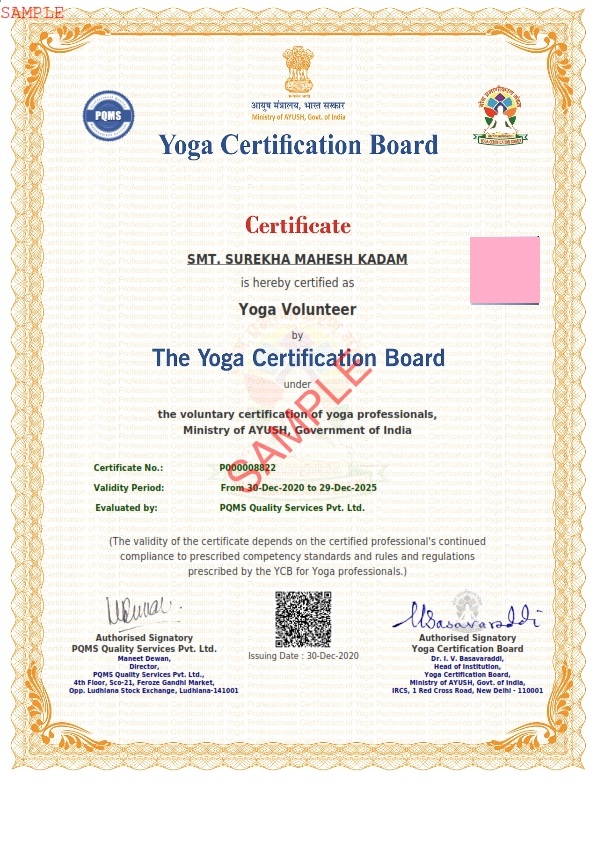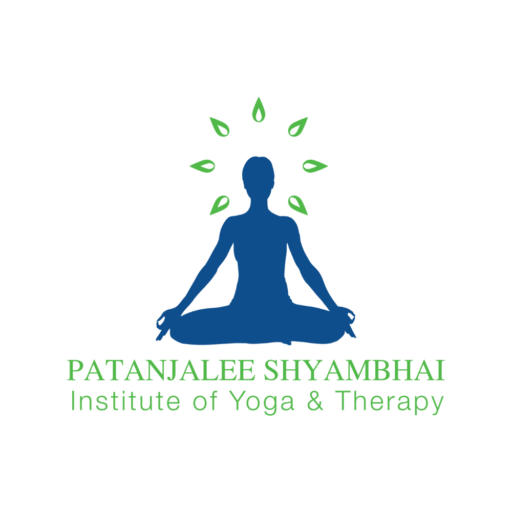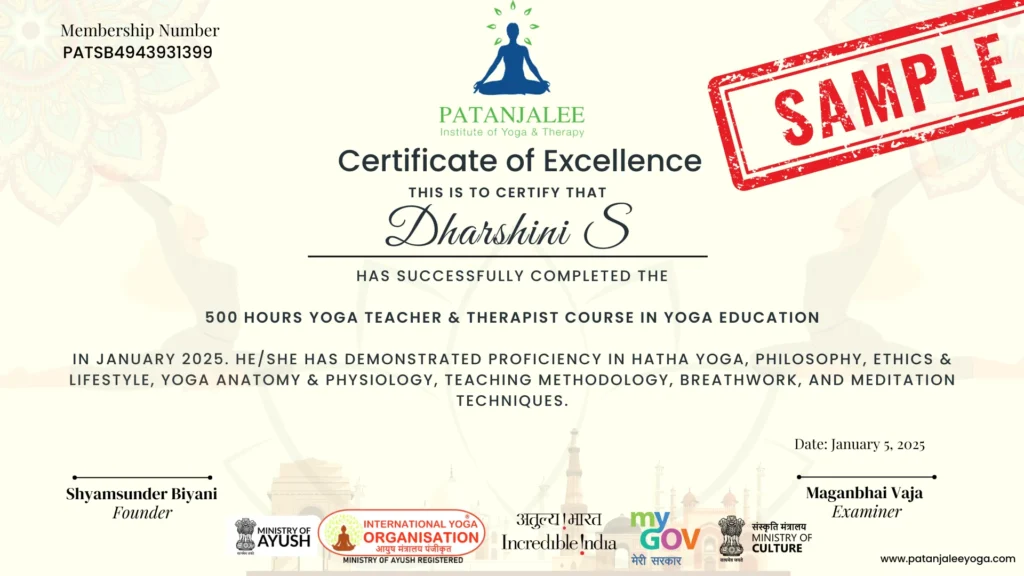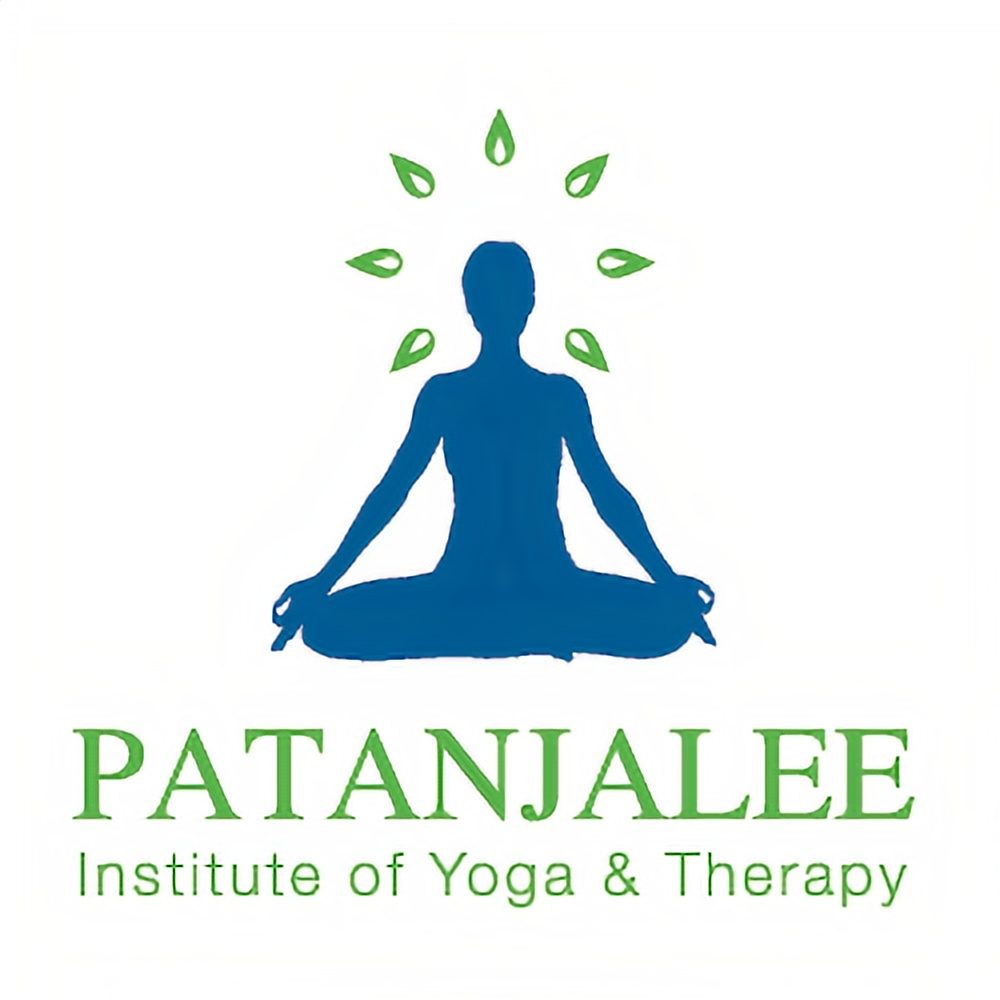
🧘♂️ 500 Hour Yoga Teacher Training Online!
🌟 Become YCB Certified Yoga Teacher
Yoga Certification Board


Transform your passion for yoga into expertise with Patanjalee Shyambhai Yoga’s 500-Hour Online Yoga Teacher Training with YCB Certification.
Our comprehensive program empowers you to become a qualified instructor, sharing the therapeutic benefits of yoga with students worldwide.
Learn from master practitioners who provide personalized guidance through every aspect of your journey.
Our curriculum seamlessly integrates ancient wisdom with contemporary teaching methods, preparing you to make yoga accessible to diverse audiences. Upon completion, your YCB Certification will validate your mastery and dedication to the practice.
Embrace this opportunity to join a growing community of educators who honor yoga’s traditional roots while meeting modern wellness needs.
Begin your teaching journey today and help others discover yoga’s transformative power.

🧘♂️ 500 Hour Yoga Teacher Training Online!
🌟 Become YCB Certified Yoga Teacher

Why Should You Join Our Online Yoga Teacher Training?
🎓 Government-Recognized Certification Earn your YCB Certification through Patanjalee Shyambhai Yoga, a prestigious credential that validates your expertise as a qualified yoga instructor. This official recognition empowers you to teach with confidence and authority across diverse settings.
🧘 Master Traditional Yoga Practice Immerse yourself in comprehensive study of classical yoga, including advanced Asana, Pranayama, meditation techniques, and foundational philosophy rooted in Vedic wisdom. Learn directly from Patanjalee Shyambhai’s expert instructors, who preserve and share authentic yogic traditions.
🚀 Launch Your Teaching Career Begin your professional journey within our supportive community. Upon graduation, gain immediate teaching opportunities through our online studio platform. Plus, access our exclusive teacher-influencer program to build your personal brand and explore collaborative partnerships in the wellness space.
Eligibility & Entry Requirements
To enroll in Level 2 (500 Hours Online Yoga Teacher Training) _ you must have completed 12th grade and hold a Level 1 (200 Hours Online Yoga Teacher Training) certification.
Course Structure
Price:

Transform your passion into expertise through Patanjalee Shyambhai Yoga’s comprehensive Teacher Training Program. Our flexible learning options—both online and in-person—allow you to master yoga instruction at your own pace while maintaining your current commitments.
Our meticulously designed curriculum encompasses all essential elements of yoga mastery:
Beyond certification, you’ll join a thriving global community of wellness practitioners dedicated to sharing yoga’s transformative benefits. Whether your goal is teaching in studios, leading private sessions, or bringing yoga to new environments, our program provides the foundation for a fulfilling career in yoga instruction.
Take the first step toward becoming a certified instructor with Patanjalee Shyambhai Yoga and discover your potential to inspire positive change through the ancient wisdom of yoga.
1.1 Yoga: Etymology, definitions (Patanjala Yoga Sutra, Bhagwad Gita & Kathopanishad), aim, objectives and misconceptions.
1.2 Yoga: Its origin, history and development.
1.3 Brief Introduction to Samkhya and Yoga Darshana.
1.4 Life sketches and teachings of Yoga masters (Maharishi Ramana, Shri Aurobindo Swami Vivekananda, Swami Dayananda Saraswati).
1.5 Principles of Yoga and practices of healthy living.
1.6 Principles and Practices of Jnana Yoga.
1.7 Principles and Practices of Bhakti Yoga.
1.8 Principles and Practices of Karma Yoga.
1.9 Concept and principles of Sukshma Vyayama, Sthula Vyayama, Surya Namaskara and their significance in Yoga Sadhana.
1.10 Concept and principles of Shatkarma: Meaning, Types, Principles and their significance in Yoga Sadhana.
1.11 Concept and principles of Yogasana: Meaning, definition, types and their significance in Yoga Sadhana.
1.12 Concept and principles of Pranayama: Meaning, definition, types and their significance in Yoga Sadhana.
1.13 Introduction to Tri Bandha and their health benefits.
1.14 Dhyana and its significance in health and well being.
1.15 Introduction to Yogic relaxation techniques with special reference to Yoga Nidra.
2.1 Introduction to Prasthanatrayee, Purushartha Chatushtaya and goal of human life.
2.2 Yoga in Kathopnishad, Prashanopanisha, Tattriyopnishad with special emphasis on Panchakosha Vivek and Ananda Mimamsa.
2.3 Concept of Sthitaprajna, Bhakti, Karma and Dhyana in Bhagavad Gita.
2.4 Significance of Bhagavad Gita in day to day life.
2.5 Concept of healthy living in Bhagavad Gita (Ahara, Vihara, Achara, Vichara).
2.6 Study of Patanjal Yoga Sutra including selected sutras from following chapters (I- 1 to 12, II-46 – 51, III- 1 to 4).
2.7 Concept of Chitta, Chitta Bhumi, Chitta Vritti, Chitta Vikshepa, Chittaprasadanam and their relationship with wellness.
2.8 Bahiranga Yoga of Maharishi Patanjali (Yama, Niyama, Asana, Pranayama, Pratyahara).
2.9 Antaranga Yoga of Maharisi Patanjali (Dharana, Dhyana, Samadhi).
2.10 Concept of mental well being according to Patanjala Yoga.
2.11 Hatha Yoga: Its parampara, knowledge of basic Yoga texts (Hatha Pradipika and Gherand Samhita). Relationship between Hatha yoga and Raja Yoga.
2.12 Sadhaka and Badhaka tatva, principle to be followed by Hatha Yoga practitioner.
2.13 Concept of Matha, Mitahara, Pathya & Apthaya.
2.14 Concepts of Nadis, Prana and Pranayama for Subjective experiences.
2.15 Knowledge of Hatha Yoga practices for wellness (Shatkarma, Asanas, Pranayama, Mudra, Nadaanusandhana).
3.1 General introduction to human body and nine major systems of human body.
3.2 Introductions to sensory organs (Eyes, Nose, Ears, Tongue and Skin).
3.3 Basic functions of nine major systems of human body and homeostasis.
3.4 Yogic concept of health and wellness.
3.5 Concept of Tridoshas, Sapta Dhatu, Agni, Vayu and Mala; their role in wellness.
3.6 Concepts of Dinacharya and Ritucharya and their importance in well being.
3.7 Importance of Ahara, Nidra and Brahmacharya in well being.
3.8 Yogic concept of mental hygiene: Maitre, Karuna, Mudita & Upeksha).
3.9 Importance of psychosocial environment for health and wellness.
3.10 Yogic concept and principles of Ahara(Mitahara, Yuktahara).
3.11 Health benefits of Suryanamaskara, Shatkarma, Asanas, Pranayama and practices leading to Dhyana (as per the practical syllabus of the course).
3.12 Salient features and contra indications of Yoga practices for well being (as per the practical syllabus of the course).
3.13 Knowledge of common diseases; their prevention and management by Yoga.
3.14 Knowledge of role of Yoga in the management of non communicable diseases.
3.15 Concept of stress and Yogic management of stress and its consequences.
1.1 Concept and Recitation of Pranava
1.2 Concept and Recitation of Hymns
1.3 Selected universal prayers, invocations and Nishpatti Bhava
2.1 Neti: Sutra Neti and Jala Neti
2.2 Dhauti: Vamana Dhauti (Kunjal)
2.3 Kapalabhati (Vatakrama)
– Neck Movement
– Griva Shakti Vikasaka (I,II,III,IV)
– Shoulder Movement
– Bhuja Valli Shakti Vikasaka
– Purna Bhuja Shakti Vikasaka
– Trunk Movement
– Kati Shakti Vikasaka (I, II, III, IV, V)
– Knee Movement
– Jangha Shakti Vikasaka (II-A&B)
– Janu Shakti Vikasaka
– Ankle movement
– Pada-mula shakti Vikasaka-A&B
– Gulpha-pada-pristha-pada-tala shakti Vikasaka
– Sarvanga Pushti
– Hrid Gati (Engine daud)
5.1 Tadasana, Hastottanasana, Vrikshasana
5.2 Ardha Chakrasana, Padahastasana
5.3 Trikonasana, Parshva Konasana, Katichakrasana
5.4 Dandasana, Padmasana, Vajarasana
5.5 Yogamudrasana, Parvatasana
5.6 Bhadrasana, Mandukasana, Ushtrasana, Shashankasana, Uttana Mandukasana
5.7 Paschimottanasana, Purvottanasana
5.8 Vakrasana, Ardha Matsyendrasana, Gomukhasana
5.9 Makarasana, Bhujangasana, Shalabhasana, Dhanurasana
5.10 Pavanamuktasana and its variations
5.11 Uttanapadasana, Ardha Halasana, Setubandhasana, Sarala-Matsyasana
5.12 Shavasana
6.1 Sectional Breathing (Abdominal, Thoracic and Clavicular Breathing)
6.2 Yogic Deep Breathing
6.3 Anuloma Viloma/Nadi Shodhana
7.1 Concept of Puraka, Rechaka and Kumbhaka
7.2 Ujjayee Pranayama (Without Kumbhaka)
7.3 Sheetalee Pranayama (Without Kumbhaka)
7.4 Sitkaree Pranayama (Without Kumbhaka)
7.5 Bhramaree Pranayama (Without Kumbhaka)
8.1 Jalandhara Bandha
8.2 Uddiyana Bandha
8.3 Mula Bandha
9.1 Yoga Mudra
9.2 Maha Mudra
9.3 Vipareetakarani Mudra
10.1 Body awareness and Breath awareness
10.2 Yoga Nidra
10.3 Antarmauna
10.4 Recitation of Pranava and Soham
10.5 Recitation of Hymns
10.6 Practice of Dhyana
1.1 Teaching methods with special reference to Yoga
1.2 Factors influencing Yoga teaching
1.3 Need of teaching practice and its use in Yogic practice
1.4 Teaching Aids: Meaning and Need, Role of Language, Voice, Fluency, Clarity and Body language in an ideal presentation
1.5 Methods of teaching Yoga to an individual, small group and large group
1.6 Lecture cum demonstration in Yoga: Its meaning, importance and method of its Presentation
1.7 Lesson plan: Its meaning and need
1.8 Preparation of lesson plan in Yoga, Preparation of lesson plan for an individual and for a group
1.9 Presentation of lessons in specific Yogic practices: Kriya, Asana, Pranayama, and Dhyana
1.10 Assessment of a Yoga class (detection and correction of mistakes)

Attendance & Participation
Academic Standards
Ethical Guidelines
Policy Compliance

Our 900-hour course offers advanced training in yoga, Ayurveda, and meditation, achieving YCB certification and mastery for seasoned practitioners and dedicated teachers alike.
At Patanjalee Shyambhai, we offer a 200-hour online yoga teacher training that immerses you in asanas, meditation, and philosophy, leading to YCB certification and holistic growth.
Our Pregnancy Yoga Teacher Training covers safe prenatal practices, breathing techniques, & meditation, preparing you to guide expectant mothers with confidence, care & YCB certification.
Patanjalee Shyambhai Inst of Yoga & Therapy
A1003, Sanghvi S3 Eco City,
Mahajan Wadi,
Mira Road East Thane - 401107
shyamsunderbiyani24@gmail.com
+91 892 812 6174
+91 961 940 9657
Monday/Friday: 5am to 7pm
Saturday: 9am to 5.30pm
Sunday: Holiday or with prior appointments
